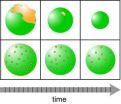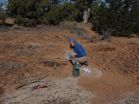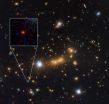(Press-News.org) RICHLAND, Wash. -- Pollution from fossil fuel burning and forest fires reaches all the way to the Arctic, even though it should decay long before it travels that far. Now, lab research can explain how pollution makes its lofty journey: rather than ride on the surface of airborne particles, pollutants snuggle inside, protected from the elements on the way. The results will help scientists improve atmospheric air-quality and pollution transport models.
The results also show that the particles that envelop pollutants also benefit from this arrangement. The new study in Environmental Science & Technology shows that the airborne particles, made from natural molecules mostly given off by live or burning plants, last longer with a touch of pollutant packed inside. The pollutants are known as polycyclic aromatic hydrocarbons, or PAHs, and are regulated by environmental agencies due to their toxicity.
"What we've learned through fundamental studies on model systems in the lab has very important implications for long-range transport of pollutants in the real world," said physical chemist Alla Zelenyuk of the Department of Energy's Pacific Northwest National Laboratory. "In this study, we propose a new explanation for how PAHs get transported so far, by demonstrating that airborne particles become a protective vessel for PAH transport."
Floating in the air and invisible to the eye, airborne particles known as secondary organic aerosols live and die. Born from carbon-based molecules given off by trees, vegetation, and fossil fuel burning, these airborne SOA particles travel the currents and contribute to cloud formation. Along for the ride are pollutants, the PAHs, that have long been thought to coat the particles on their surface.
For decades, atmospheric scientists have been trying to explain how atmospheric particles manage to transport harmful pollutants to pristine environments thousands of miles away from their starting point. The particles collected in areas such as the Arctic also pack higher concentrations of pollutants than scientists' computer models predict.
The predictions are based on the assumption that the particles are like liquid spheres, whose fluidity allows PAHs to escape. But they don't escape, and one recent advance has helped to pin down why PAHs are remaining stuck in their particle lairs. Zelenyuk and her colleagues at EMSL, DOE's Environmental Molecular Sciences Laboratory at PNNL, developed an ultra-sensitive instrument that can determine the size, composition and shape of individual particles.
Called SPLAT II, the instrument can analyze millions of tiny particles one by one. The ability of this novel instrument to characterize individual particles provides unique insight into their property and evolution.
Using SPLAT II to evaluate laboratory-generated SOA particles from alpha-pinene, the molecule that gives pine trees their piney smell, Zelenyuk has already discovered that SOA particles aren't liquid at all. Her team's recent work revealed they are more like tar -- thick, viscous blobs that are too solid to be liquid and too liquid to be solid.
Armed with this data, Zelenyuk and researchers from Imre Consulting in Richland and the University of Washington in Seattle set out to determine the relation between the SOA particle and the PAHs. Again they used alpha-pinene for the SOA. For the PAH, they used pyrene, a toxic pollutant produced by burning fossil fuels or vegetation such as forests.
They created two kinds of particles. The first kind exemplified the classical SOA: first they produced the particles with alpha-pinene and then coated them with pyrene. The second kind resembled what likely happens in nature: they mixed alpha-pinene and pyrene and let the particles form with both molecules present. Then they sent the particles through SPLAT and watched what happened to them over time.
With the pyrene-coated particles, the team found the PAH pyrene evaporating off the surface of the particle quickly, all of it gone after four hours. By the next day, the particle itself had shrunk by about 70 percent, showing that the alpha-pinene SOA also evaporates, although more slowly than pyrene.
When they created the particles in the presence of both SOA and PAH, the PAH evaporated much more slowly. Fifty percent of the original PAH still remained in the particle after 24 hours. In addition, the SOA particle itself stayed bulky, losing less than 20 percent of its volume.
These results showed the team that PAHs become trapped within the highly viscous SOA particles, where they remain protected from the environment. The symbiotic relationship between the atmospheric particles and pollutants surprised Zelenyuk: SOAs help PAHs travel the world, and the PAHs help SOAs survive longer.
Zelenyuk and her colleagues performed comparable experiments with other PAHs and SOAs and found similar results.
In the real world, Zelenyuk said, the evaporation will be even slower. These results will help modelers better simulate atmospheric SOA particles and transport of pollutants over long distances.
This work was supported by the Department of Energy Office of Science and PNNL's Chemical Imaging Initiative.
INFORMATION:
Reference: Alla Zelenyuk, Dan Imre, Josef Beránek, Evan Abramson, Jacqueline Wilson and Manish Shrivastava, Synergy between Secondary Organic Aerosols and Long-Range Transport of Polycyclic Aromatic Hydrocarbons, Environmental Science & Technology, Nov. 7, 2012, doi: 10.1021/es302743z.
EMSL, the Environmental Molecular Sciences Laboratory, is a national scientific user facility sponsored by the Department of Energy's Office of Science. Located at Pacific Northwest National Laboratory in Richland, Wash., EMSL offers an open, collaborative environment for scientific discovery to researchers around the world. Its integrated computational and experimental resources enable researchers to realize important scientific insights and create new technologies. Follow EMSL on Facebook, LinkedIn and Twitter.
Interdisciplinary teams at Pacific Northwest National Laboratory address many of America's most pressing issues in energy, the environment and national security through advances in basic and applied science. PNNL employs 4,500 staff, has an annual budget of nearly $1 billion, and has been managed for the U.S. Department of Energy by Ohio-based Battelle since the laboratory's inception in 1965. For more, visit the PNNL's News Center, or follow PNNL on Facebook, LinkedIn and Twitter.
DOE's Office of Science is the single largest supporter of basic research in the physical sciences in the United States, and is working to address some of the most pressing challenges of our time. For more information, please visit science.energy.gov.
Airborne particles smuggle pollutants to far reaches of globe
Symbiotic relationship between pollutants and airborne particles explains how city pollution ends up in Arctic
2012-11-16
ELSE PRESS RELEASES FROM THIS DATE:
Simplifying heart surgery with stretchable electronics devices
2012-11-16
Researchers at the McCormick School of Engineering are part of a team that has used stretchable electronics to create a multipurpose medical catheter that can both monitor heart functions and perform corrections on heart tissue during surgery.
The device marks the first time stretchable electronics have been applied to a surgical process known as cardiac ablation, a milestone that could lead to simpler surgeries for arrhythmia and other heart conditions. The researchers had previously demonstrated the concept to apply stretchable electronics to heart surgery, but with ...
Medical vital-sign monitoring reduced to the size of a postage stamp
2012-11-16
CORVALLIS, Ore. – Electrical engineers at Oregon State University have developed new technology to monitor medical vital signs, with sophisticated sensors so small and cheap they could fit onto a bandage, be manufactured in high volumes and cost less than a quarter.
A patent is being processed for the monitoring system and it's now ready for clinical trials, researchers say. When commercialized, it could be used as a disposable electronic sensor, with many potential applications due to its powerful performance, small size, and low cost.
Heart monitoring is one obvious ...
Video-article shows how to purify magnetic bacteria
2012-11-16
Magnetotactic bacteria, like Magnetospirillum magneticum, have evolved cellular processes that allow them to take up iron molecules to produce magnetic nanocrystals like magnetite. Since they were first discovered and isolated in 1975 by Robert Blakemore, scientists continue to be fascinated by these unique bacteria, whether as a means to isolate biogenic magnetite or to understand the evolutionary advantages of producing these minerals. A new video-article in JoVE (Journal of Visualized Experiments) details a procedure to purify and enrich samples of magnetotactic bacteria ...
Researchers report potential new treatment to stop Alzheimer's disease
2012-11-16
Last March, researchers at UCLA reported the development of a molecular compound called CLR01 that prevented toxic proteins associated with Parkinson's disease from binding together and killing the brain's neurons.
Building on those findings, they have now turned their attention to Alzheimer's disease, which is thought to be caused by a similar toxic aggregation or clumping, but with different proteins, especially amyloid-beta and tau.
And what they've found is encouraging. Using the same compound, which they've dubbed a "molecular tweezer," in a living mouse model ...
WSU scientists find new way for antibiotic resistance to spread
2012-11-16
PULLMAN, Wash.—Washington State University researchers have found an unlikely recipe for antibiotic resistant bacteria: Mix cow dung and soil, and add urine infused with metabolized antibiotic. The urine will kill off normal E. coli in the dung-soil mixture. But antibiotic-resistant E. coli will survive in the soil to recolonize in a cow's gut through pasture, forage or bedding.
"I was surprised at how well this works, but it was not a surprise that it could be happening," says Doug Call, a molecular epidemiologist in WSU's Paul G. Allen School for Global Animal Health. ...
Young gamers offer insight to teaching new physicians robotic surgery
2012-11-16
What can high school and college-age video game enthusiasts teach young surgeons-in-training?
According to a new study from researchers at the University of Texas Medical Branch at Galveston (UTMB) – a world leader in minimally invasive and robotic surgery – the superior hand-eye coordination and hand skills gained from hours of repetitive joystick maneuvers mimic the abilities needed to perform today's most technologically-advanced robotic surgeries.
To offer insight on how best to train future surgeons, the study placed high school and college students head to head ...
Degraded military lands to get ecological boost from CU-led effort
2012-11-16
Some arid lands in the American West degraded by military exercises that date back to General George Patton's Word War II maneuvers in the Mojave Desert should get a boost from an innovative research project led by the University of Colorado Boulder.
Headed up by CU-Boulder Assistant Professor Nichole Barger, the research team is focused on developing methods to restore biological soil crusts -- microbial communities primarily concentrated on soil surfaces critical to decreasing erosion and increasing water retention and soil fertility. Such biological soil crusts, known ...
Hubble helps find candidate for most distant object in the universe yet observed
2012-11-16
By combining the power of the NASA/ESA Hubble Space Telescope, NASA's Spitzer Space Telescope and one of nature's zoom lenses, astronomers have found what is probably the most distant galaxy yet seen in the Universe. The object offers a peek back into a time when the Universe was only 3 percent of its present age of 13.7 billion years.
We see the newly discovered galaxy, named MACS0647-JD, as it was 420 million years after the Big Bang. Its light has travelled for 13.3 billion years to reach Earth, which corresponds to a redshift of approximately 11 [1].
This is the ...
Quick, high-volume test offers fast track in search for Alzheimer's drugs
2012-11-16
An efficient, high-volume technique for testing potential drug treatments for Alzheimer's disease uncovered an organic compound that restored motor function and longevity to fruit flies with the disease, according to new research that could help put the search for an effective Alzheimer's drug on a faster track.
Princeton University researchers report in the Journal of Biological Chemistry that they discovered an organic compound that prevented the formation of protein clumps, or aggregates, found on human brain cells afflicted by Alzheimer's disease. The researchers ...
Neurons made from stem cells drive brain activity after transplantation in laboratory model
2012-11-16
LA JOLLA, Calif., November 15, 2012 – Researchers and patients look forward to the day when stem cells might be used to replace dying brain cells in Alzheimer's disease and other neurodegenerative conditions. Scientists are currently able to make neurons and other brain cells from stem cells, but getting these neurons to properly function when transplanted to the host has proven to be more difficult. Now, researchers at Sanford-Burnham Medical Research Institute (Sanford-Burnham) have found a way to stimulate stem cell-derived neurons to direct cognitive function after ...
LAST 30 PRESS RELEASES:
UVA’s Jundong Li wins ICDM’S 2025 Tao Li Award for data mining, machine learning
UVA’s low-power, high-performance computer power player Mircea Stan earns National Academy of Inventors fellowship
Not playing by the rules: USU researcher explores filamentous algae dynamics in rivers
Do our body clocks influence our risk of dementia?
Anthropologists offer new evidence of bipedalism in long-debated fossil discovery
Safer receipt paper from wood
Dosage-sensitive genes suggest no whole-genome duplications in ancestral angiosperm
First ancient human herpesvirus genomes document their deep history with humans
Why Some Bacteria Survive Antibiotics and How to Stop Them - New study reveals that bacteria can survive antibiotic treatment through two fundamentally different “shutdown modes”
UCLA study links scar healing to dangerous placenta condition
CHANGE-seq-BE finds off-target changes in the genome from base editors
The Journal of Nuclear Medicine Ahead-of-Print Tip Sheet: January 2, 2026
Delayed or absent first dose of measles, mumps, and rubella vaccination
Trends in US preterm birth rates by household income and race and ethnicity
Study identifies potential biomarker linked to progression and brain inflammation in multiple sclerosis
Many mothers in Norway do not show up for postnatal check-ups
Researchers want to find out why quick clay is so unstable
Superradiant spins show teamwork at the quantum scale
Cleveland Clinic Research links tumor bacteria to immunotherapy resistance in head and neck cancer
First Editorial of 2026: Resisting AI slop
Joint ground- and space-based observations reveal Saturn-mass rogue planet
Inheritable genetic variant offers protection against blood cancer risk and progression
Pigs settled Pacific islands alongside early human voyagers
A Coral reef’s daily pulse reshapes microbes in surrounding waters
EAST Tokamak experiments exceed plasma density limit, offering new approach to fusion ignition
Groundbreaking discovery reveals Africa’s oldest cremation pyre and complex ritual practices
First breathing ‘lung-on-chip’ developed using genetically identical cells
How people moved pigs across the Pacific
Interaction of climate change and human activity and its impact on plant diversity in Qinghai-Tibet plateau
From addressing uncertainty to national strategy: an interpretation of Professor Lim Siong Guan’s views
[Press-News.org] Airborne particles smuggle pollutants to far reaches of globeSymbiotic relationship between pollutants and airborne particles explains how city pollution ends up in Arctic





